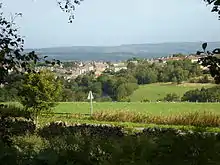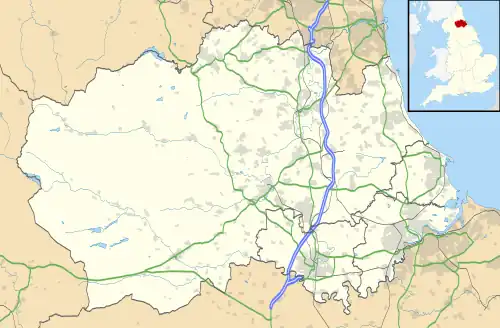
| Castleside | |
|---|---|
 Castleside Location within County Durham | |
| Population | 1,654 (2008) |
| OS grid reference | NZ078488 |
| Civil parish | |
| Unitary authority | |
| Ceremonial county | |
| Region | |
| Country | England |
| Sovereign state | United Kingdom |
| Post town | CONSETT |
| Postcode district | DH8 |
| Dialling code | 01207 |
| Police | Durham |
| Fire | County Durham and Darlington |
| Ambulance | North East |
| UK Parliament | |
Castleside is a village in County Durham, England.[1] [2] It is situated a short distance to the south-west of Consett. Castleside is covered by the civil parish of Healeyfield.The village centre is located on the main A68 road which runs between Edinburgh and Darlington and the village crossroads allow easy access to Consett, the North Pennines and Stanhope. To the northeast lie other small villages called Moorside and The Grove.
The parish church, dedicated to St John, was designed by Ewan Christian and is a reproduction of a church he had seen and admired while on holiday in Switzerland. The church was consecrated on 7 March 1867.
There was a Wesleyan Chapel at Watergate, Castleside, which was erected in 1805.[3] The chapel was extended in 1877[4] and closed in 1970.[5] A Primitive Methodist chapel was erected in 1843 on the Consett Road, and extended in 1884.[6] It closed in the 1990s and is now a residence.[7]
The nearby dwelling of Wharnley Burn is a 14th century cottage and was home to the moss trooper Thomas Raw (d. 1714). He was buried in a field near his home believing he could not be buried in a church. In the early 1860s the grave was opened and the grave slab removed, supposedly to Satley.[8]
The road to Consett, running north east, leads to the small villages of Moorside and The Grove.
Moorside is a large post-World War II housing estate. It was originally the lands of Consett Park mentioned in 1352 as "half of the manor of Conkesbeved, excepting the park of Conkesheved [now Consett Park]".(Conkesheved being the name for Consett). The manor of Consett and the park of Consett seem to have been two separate entities. The "park of Consett", in 1437, was leased to Henry Vasey. It is unclear who held the lands later, however in the 1850s Consett Park had been owned by the Rippon family for over 200 years, acquired in 1635 by Charles Rippon. [9][10][11]
A row of terraced housing was built (1896-1900) on the brow of the hill and called Consett Park Terrace.[12] The housing estate was built after the Second World War with the streets named after English counties. A second phase of building took places in the 1950s including the building of a Roman Catholic church, St Pius X, built in 1954 to designs by the local architect Anthony Jospeh Rossi (1916-1971).[13][14] The church was demolished in 2009 and replaced by a smaller church in the same year. As part of the 1950s building phase, the buildings of Consett Park were demolished. They were located near the intersection of Sussex Road and Surrey Cresent.
A light industrial estate was established in 1950 in the Castleside /Moorside area.[15]
References
- ↑ Ordnance Survey: Landranger map sheet 88 Newcastle upon Tyne (Durham & Sunderland) (Map). Ordnance Survey. 2012. ISBN 9780319229989.
- ↑ "Ordnance Survey: 1:50,000 Scale Gazetteer" (csv (download)). www.ordnancesurvey.co.uk. Ordnance Survey. 1 January 2016. Retrieved 30 January 2016.
- ↑ Whelan, William (1856). History, topography, and directory of the county palatine of Durham. Whittaker. p. 908.
- ↑ Kelly's Directory of Durham. 1890. p. 49.
- ↑ "Durham at War".
- ↑ Kelly's Directory of Durham. 1890. p. 49.
- ↑ "My Primitive Methodists".
- ↑ Neasham, George (1893). North-country sketches, notes, essays and reviews. pp. 292–294.
- ↑ Fawcett, J.W. (1922). "The manor of Consett". Proceedings of the Society of Antiquaries of Newcastle upon Tyne. 10 (3rd. series) (27): 345–48.
- ↑ Fordyce, William (1857). The History and Antiquities of the County Palatine of Durham. p. 703.
- ↑ Surtees, Robert (1820). The History and Antiquities of the County Palatine of Durham: Volume 2, Chester Ward. pp. 284–297.
- ↑ Fawcett, J.W. (1925). "The Township of Knitsley, Co. Durham". Archaeologia Aeliana. 1 (ser. 4): 37. doi:10.5284/1059802.
- ↑ Pevsner, Nicholas (2002). The buidings of England: Durham (2nd ed.). p. 132.
- ↑ "Taking Stock: Catholic Churches of England and Wales".
- ↑ Consett Urban Distrit Council. Report 1950. p. 5
External links